Hwangryunhaedok-Tang Exerts Neuropreventive Effect on Memory Impairment by Reducing Cholinergic System Dysfunction and Inflammatory Response in a Vascular Dementia Rat Model
Abstract
:1. Introduction
2. Results
2.1. Inhibitory Effects of the Ethanol Extract of HRT and Commercial HRT Granules on AChE Activity
2.2. Effect of HRT on Cognitive Impairment in the BCCAO-Induced VaD Rat Model
2.3. Protective Effect of HRT against Neuronal Cell Loss in the BCCAO-Induced VaD Rat Model
2.4. Effect of HRT on BCCAO-Induced Modification of Acetylcholine (ACh) Level and AChE Activity in Rats
2.5. Effect of HRT on Glial Cell Activation in the BCCAO-Induced VaD Rat Model
2.6. Effect of HRT on Mitogen-Activated Protein Kinase (MAPK) Signaling in the BCCAO-Induced VaD Rat Model
2.7. High-Performance Liquid Chromatography (HPLC) Determination of the Seven Components in HRT
3. Discussion
4. Materials and Methods
4.1. Herbal Materials
4.2. Preparation of HRT Samples
4.3. In Vitro Assay for AChE Inhibitory Activity
4.4. Animal Preparation and Surgical Procedures
4.5. Animal Experimental Design
4.6. Spontaneous Alternation Behavior Test
4.7. Novel Object Recognition Test
4.8. Measurement of ACh Level and AChE Activity Assay
4.9. Nissl Staining and Immunohistochemistry
4.10. Sodium Dodecyl Sulfate (SDS)-PAGE Analysis
4.11. Chemicals and Reagents for HPLC Analysis
4.12. Chromatographic Analysis
4.13. Statistical Analysis
Author Contributions
Funding
Acknowledgments
Conflicts of Interest
References
- Hur, J. Donguibogam; Namsadang: Seoul, Korea, 2007; p. 382. [Google Scholar]
- Shin, N.R.; Ko, J.W.; Park, S.H.; Cho, Y.K.; Oh, S.R.; Ahn, K.S.; Ryu, J.M.; Kim, J.C.; Seo, C.S.; Shin, I.S. Protective effect of HwangRyunHaeDok-Tang water extract against chronic obstructive pulmonary disease induced by cigarette smoke and lipopolysaccharide in a mouse model. J. Ethnopharmacol. 2017, 200, 60–65. [Google Scholar] [CrossRef] [PubMed]
- Zhu, B.; Cao, H.; Sun, L.; Li, B.; Guo, L.; Duan, J.; Zhu, H.; Zhang, Q. Metabolomics-based mechanisms exploration of Huang-Lian Jie-Du decoction on cerebral ischemia via UPLC-Q-TOF/MS analysis on rat serum. J. Ethnopharmacol. 2018, 216, 147–156. [Google Scholar] [CrossRef] [PubMed]
- Jeon, W.K.; Ma, J.; Choi, B.R.; Han, S.H.; Jin, Q.; Hwang, B.Y.; Han, J.S. Effects of Fructus mume Extract on MAPK and NF-kappaB Signaling and the Resultant Improvement in the Cognitive Deficits Induced by Chronic Cerebral Hypoperfusion. Evid. Based Complement. Altern. Med. 2012, 2012, 450838. [Google Scholar] [CrossRef] [PubMed]
- Park, H.S.; Wijerathne, C.U.B.; Jeong, H.Y.; Seo, C.S.; Ha, H.; Kwun, H.J. Gastroprotective effects of Hwanglyeonhaedok-tang against Helicobacter pylori-induced gastric cell injury. J. Ethnopharmacol. 2018, 216, 239–250. [Google Scholar] [CrossRef] [PubMed]
- Kim, H.; Kim, I.; Lee, M.C.; Kim, H.J.; Lee, G.S.; Kim, H.; Kim, B.J. Effects of Hwangryunhaedok-tang on gastrointestinal motility function in mice. World J. Gastroenterol. 2017, 23, 2705–2715. [Google Scholar] [CrossRef] [PubMed]
- Bereczki, E.; Francis, P.T.; Howlett, D.; Pereira, J.B.; Höglund, K.; Bogstedt, A.; Cedazo-Minguez, A.; Baek, J.H.; Hortobágyi, T.; Attems, J.; et al. Synaptic proteins predict cognitive decline in Alzheimer’s disease and Lewy body dementia. Alzheimers Dement. 2016, 12, 1149–1158. [Google Scholar] [CrossRef] [PubMed]
- Burns, A.; Iliffe, S. Dementia. BMJ 2009, 338, b75. [Google Scholar] [CrossRef] [PubMed]
- O’Brien, J.T.; Thomas, A. Vascular dementia. Lancet 2015, 386, 1698–1706. [Google Scholar] [CrossRef] [Green Version]
- Kalaria, R. Similarities between Alzheimer’s disease and vascular dementia. J. Neurol. Sci. 2002, 203–204, 29–34. [Google Scholar] [CrossRef]
- Wallin, A.; Sjögren, M.; Blennow, K.; Davidsson, P. Decreased cerebrospinal fluid acetylcholinesterase in patients with subcortical ischemic vascular dementia. Dement. Geriatr. Cogn. Disord. 2003, 16, 200–207. [Google Scholar] [CrossRef]
- Román, G.C.; Kalaria, R.N. Vascular determinants of cholinergic deficits in Alzheimer disease and vascular dementia. Neurobiol. Aging 2006, 27, 1769–1785. [Google Scholar] [CrossRef] [PubMed]
- Pavlov, V.A.; Tracey, K.J. The cholinergic anti-inflammatory pathway. Brain Behav. Immun. 2005, 19, 493–499. [Google Scholar] [CrossRef] [PubMed]
- Okamoto, H.; Chino, A.; Hirasaki, Y.; Ueda, K.; Iyo, M.; Namiki, T. Orengedoku-to augmentation in cases showing partial response to yokukan-san treatment: A case report and literature review of the evidence for use of these Kampo herbal formulae. Neuropsychiatr. Dis. Treat. 2013, 9, 151–155. [Google Scholar] [CrossRef] [PubMed]
- Yu, C.J.; Zheng, M.F.; Kuang, C.X.; Huang, W.D.; Yang, Q. Oren-gedoku-to and its constituents with therapeutic potential in Alzheimer’s disease inhibit indoleamine 2,3-dioxygenase activity in vitro. J. Alzheimer Dis. 2010, 22, 257–266. [Google Scholar] [CrossRef] [PubMed]
- Durairajan, S.S.; Huang, Y.Y.; Yuen, P.Y.; Chen, L.L.; Kwok, K.Y.; Liu, L.F.; Song, J.X.; Han, Q.B.; Xue, L.; Chung, S.K.; et al. Effects of Huanglian-Jie-Du-Tang and its modified formula on the modulation of amyloid-beta precursor protein processing in Alzheimer’s disease models. PLoS ONE 2014, 9, e92954. [Google Scholar] [CrossRef] [PubMed]
- Fang, Q.; Zhan, X.P.; Mo, J.L.; Sun, M. The effect of Huanglian Jiedu Tang on Alzheimer’s disease and its influence on cytokines. China J. Chin. Mater. Med. 2004, 29, 575–578. [Google Scholar]
- Rocher, M.N.; Carre, D.; Spinnewyn, B.; Schulz, J.; Delaflotte, S.; Pignol, B.; Chabrier, P.E.; Auguet, M. Long-term treatment with standardized Ginkgo biloba extract (EGb 761) attenuates cognitive deficits and hippocampal neuron loss in a gerbil model of vascular dementia. Fitoterapia 2011, 82, 1075–1080. [Google Scholar] [CrossRef]
- Wang, J.; Zhang, H.Y.; Tang, X.C. Cholinergic deficiency involved in vascular dementia: Possible mechanism and strategy of treatment. Acta Pharmacol. Sin. 2009, 30, 879–888. [Google Scholar] [CrossRef]
- Belkhelfa, M.; Beder, N.; Mouhoub, D.; Amri, M.; Hayet, R.; Tighilt, N.; Bakheti, S.; Laimouche, S.; Azzouz, D.; Belhadj, R.; et al. The involvement of neuroinflammation and necroptosis in the hippocampus during vascular dementia. J. Neuroimmunol. 2018, 320, 48–57. [Google Scholar] [CrossRef]
- Suzumura, A. Neuron-microglia interaction in neuroinflammation. Curr. Protein Pept. Sci. 2013, 14, 16–20. [Google Scholar] [CrossRef]
- Lee, K.M.; Bang, J.; Kim, B.Y.; Lee, I.S.; Han, J.S.; Hwang, B.Y.; Jeon, W.K. Fructus mume alleviates chronic cerebral hypoperfusion-induced white matter and hippocampal damage via inhibition of inflammation and downregulation of TLR4 and p38 MAPK signaling. BMC Complement. Altern. Med. 2015, 15, 125. [Google Scholar] [CrossRef] [PubMed]
- Nanri, M.; Watanabe, H. Availability of 2VO rats as a model for chronic cerebrovascular disease. Nihon Yakurigaku Zasshi 1999, 113, 85–95. [Google Scholar] [CrossRef] [PubMed]
- Jiwa, N.S.; Garrard, P.; Hainsworth, A.H. Experimental models of vascular dementia and vascular cognitive impairment: A systematic review. J. Neurochem. 2010, 115, 814–828. [Google Scholar] [CrossRef] [PubMed]
- Zhang, Z.H.; Shi, G.X.; Li, Q.Q.; Wang, Y.J.; Li, P.; Zhao, J.X.; Yang, J.W.; Liu, C.Z. Comparison of cognitive performance between two rat models of vascular dementia. Int. J. Neurosci. 2014, 124, 818–823. [Google Scholar] [CrossRef] [PubMed]
- Sarti, C.; Pantoni, L.; Bartolini, L.; Inzitari, D. Persistent impairment of gait performances and working memory after bilateral common carotid artery occlusion in the adult Wistar rat. Behav. Brain Res. 2002, 136, 13–20. [Google Scholar] [CrossRef]
- Kim, S.H.; Kang, H.S.; Kim, H.J.; Moon, Y.; Ryu, H.J.; Kim, M.Y.; Han, S.H. The effect of ischemic cholinergic damage on cognition in patients with subcortical vascular cognitive impairment. J. Geriatr. Psychiatry Neurol. 2012, 25, 122–127. [Google Scholar] [CrossRef] [PubMed]
- Moretti, A.; Gorini, A.; Villa, R.F. Pharmacotherapy and prevention of vascular dementia. CNS Neurol. Disord. Drug Targets 2011, 10, 370–390. [Google Scholar] [CrossRef]
- Wang, D.P.; Yin, H.; Kang, K.; Lin, Q.; Su, S.H.; Hai, J. The potential protective effects of cannabinoid receptor agonist WIN55,212-2 on cognitive dysfunction is associated with the suppression of autophagy and inflammation in an experimental model of vascular dementia. Psychiatry Res. 2018, 267, 281–288. [Google Scholar] [CrossRef] [PubMed]
- Liu, J.T.; Dong, M.H.; Zhang, J.Q.; Bai, Y.; Kuang, F.; Chen, L.W. Microglia and astroglia: The role of neuroinflammation in lead toxicity and neuronal injury in the brain. Neurol. Neuroimmunol. Neuroinflamm. 2015, 2, 131–137. [Google Scholar]
- Lee, K.M.; Bang, J.H.; Han, J.S.; Kim, B.Y.; Lee, I.S.; Kang, H.W.; Jeon, W.K. Cardiotonic pill attenuates white matter and hippocampal damage via inhibiting microglial activation and downregulating ERK and p38 MAPK signaling in chronic cerebral hypoperfused rat. BMC Complement. Altern. Med. 2013, 13, 334. [Google Scholar] [CrossRef]
- Sasaki, Y.; Ohsawa, K.; Kanazawa, H.; Kohsaka, S.; Imai, Y. Iba1 is an actin-cross-linking protein in macrophages/microglia. Biochem. Biophys. Res. Commun. 2001, 286, 292–297. [Google Scholar] [CrossRef] [PubMed]
- Hwang, Y.K.; Jinhua, M.; Choi, B.R.; Cui, C.A.; Jeon, W.K.; Kim, H.; Kim, H.Y.; Han, S.H.; Han, J.S. Effects of Scutellaria baicalensis on chronic cerebral hypoperfusion-induced memory impairments and chronic lipopolysaccharide infusion-induced memory impairments. J. Ethnopharmacol. 2011, 137, 681–689. [Google Scholar] [CrossRef] [PubMed]
- Sun, L.; Ding, F.; You, G.; Liu, H.; Wang, M.; Ren, X.; Deng, Y. Development and Validation of an UPLC-MS/MS Method for Pharmacokinetic Comparison of Five Alkaloids from JinQi Jiangtang Tablets and Its Monarch Drug Coptidis Rhizoma. Pharmaceutics 2017, 10, 4. [Google Scholar] [CrossRef]
- Li, S.; Liu, C.; Guo, L.; Zhang, Y.; Wang, J.; Ma, B.; Wang, Y.; Wang, Y.; Ren, J.; Yang, X.; et al. Ultrafiltration liquid chromatography combined with high-speed countercurrent chromatography for screening and isolating potential alpha-glucosidase and xanthine oxidase inhibitors from Cortex Phellodendri. J. Sep. Sci. 2014, 37, 2504–2512. [Google Scholar] [CrossRef] [PubMed]
- Xu, J.; Yu, Y.; Shi, R.; Xie, G.; Zhu, Y.; Wu, G.; Qin, M. Organ-specific metabolic shifts of flavonoids in Scutellaria baicalensis at different growth and development stages. Molecules 2018, 23, 429. [Google Scholar] [CrossRef] [PubMed]
- Zhang, X.; Pi, Z.; Zheng, Z.; Liu, Z.; Song, F. Comprehensive investigation of in-vivo ingredients and action mechanism of iridoid extract from Gardeniae Fructus by liquid chromatography combined with mass spectrometry, microdialysis sampling and network pharmacology. J. Chromatogr. B Anal. Technol. Biomed. Life Sci. 2018, 1076, 70–76. [Google Scholar] [CrossRef] [PubMed]
- Zhang, Q.; Fu, X.; Wang, J.; Yang, M.; Kong, L. Treatment effects of ischemic stroke by berberine, baicalin, and jasminoidin from Huang-Lian-Jie-Du-Decoction (HLJDD) explored by an integrated metabolomics approach. Oxid. Med. Cell Longev. 2017, 2017, 9848594. [Google Scholar] [CrossRef] [PubMed]
- Li, L.J.; Li, H.X.; Wu, X.T.; Yan, B.; Zhou, D. Effect of geniposide on vascular dementia in rats. J. Sichuan Univ. Med. Sci. Ed. 2009, 40, 604–607. [Google Scholar]
- De la Torre, J.C. Vascular basis of Alzheimer’s pathogenesis. Ann. N. Y. Acad. Sci. 2002, 977, 196–215. [Google Scholar] [CrossRef]
- Farkas, E.; Luiten, P.G. Cerebral microvascular pathology in aging and Alzheimer’s disease. Prog. Neurobiol. 2001, 64, 575–611. [Google Scholar] [CrossRef]
- Matsuda, H. Cerebral blood flow and metabolic abnormalities in Alzheimer’s disease. Ann. Nucl. Med. 2001, 15, 85–92. [Google Scholar] [CrossRef] [PubMed]
- Ghorani-Azam, A.; Sepahi, S.; Khodaverdi, E.; Mohajeri, S.A. Herbal medicine as a promising therapeutic approach for the management of vascular dementia: A systematic literature review. Phytother. Res. 2018, 32, 1720–1728. [Google Scholar] [CrossRef] [PubMed]
- Yang, X.N.; Li, C.S.; Chen, C.; Tang, X.Y.; Cheng, G.Q.; Li, X. Protective effect of Shouwu Yizhi decoction against vascular dementia by promoting angiogenesis. Chin. J. Nat. Med. 2017, 15, 740–750. [Google Scholar] [CrossRef]
- Chang, D.; Liu, J.; Bilinski, K.; Xu, L.; Steiner, G.Z.; Seto, S.W.; Bensoussan, A. Herbal medicine for the treatment of vascular dementia: An overview of scientific evidence. Evid. Based Complement. Altern. Med. 2016, 2016, 7293626. [Google Scholar] [CrossRef]
- Zeng, G.R.; Zhou, S.D.; Shao, Y.J.; Zhang, M.H.; Dong, L.M.; Lv, J.W.; Zhang, H.X.; Tang, Y.H.; Jiang, D.J.; Liu, X.M. Effect of Ginkgo biloba extract-761 on motor functions in permanent middle cerebral artery occlusion rats. Phytomedicine 2018, 48, 94–103. [Google Scholar] [CrossRef]
- Ellman, G.L.; Courtney, K.D.; Andres, V., Jr.; Feather-Stone, R.M. A new and rapid colorimetric determination of acetylcholinesterase activity. Biochem. Pharmacol. 1961, 7, 88–95. [Google Scholar] [CrossRef] [Green Version]
- De Oliveira, J.S.; Abdalla, F.H.; Dornelles, G.L.; Adefegha, S.A.; Palma, T.V.; Signor, C.; da Silva Bernardi, J.; Baldissarelli, J.; Lenz, L.S.; Magni, L.P.; et al. Berberine protects against memory impairment and anxiogenic-like behavior in rats submitted to sporadic Alzheimer’s-like dementia: Involvement of acetylcholinesterase and cell death. Neurotoxicology 2016, 57, 241–250. [Google Scholar] [CrossRef]
- Zhao, R.R.; Xu, F.; Xu, X.C.; Tan, G.J.; Liu, L.M.; Wu, N.; Zhang, W.Z.; Liu, J.X. Effects of alpha-lipoic acid on spatial learning and memory, oxidative stress, and central cholinergic system in a rat model of vascular dementia. Neurosci. Lett. 2015, 587, 113–119. [Google Scholar] [CrossRef]
- Kim, D.H.; Hung, T.M.; Bae, K.H.; Jung, J.W.; Lee, S.; Yoon, B.H.; Cheong, J.H.; Ko, K.H.; Ryu, J.H. Gomisin A improves scopolamine-induced memory impairment in mice. Eur. J. Pharmacol. 2006, 542, 129–135. [Google Scholar] [CrossRef]
- Yogesh Kanna, S.; Kathiravan, K.; Pradeep Kumar, N.; Ramesh Kumar, R. Restorative Effects of Glycyrrhizic Acid on Neurodegeneration and Cognitive Decline in Chronic Cerebral Hypoperfusion Model of Vascular Dementia in Rats. Int. J. Anat. Sci. 2014, 5, 57–65. [Google Scholar]
Sample Availability: Samples of the compounds geniposide, baicalin, baicalein, wogonin, coptisine, palmatine, and berberine are commercially available. |

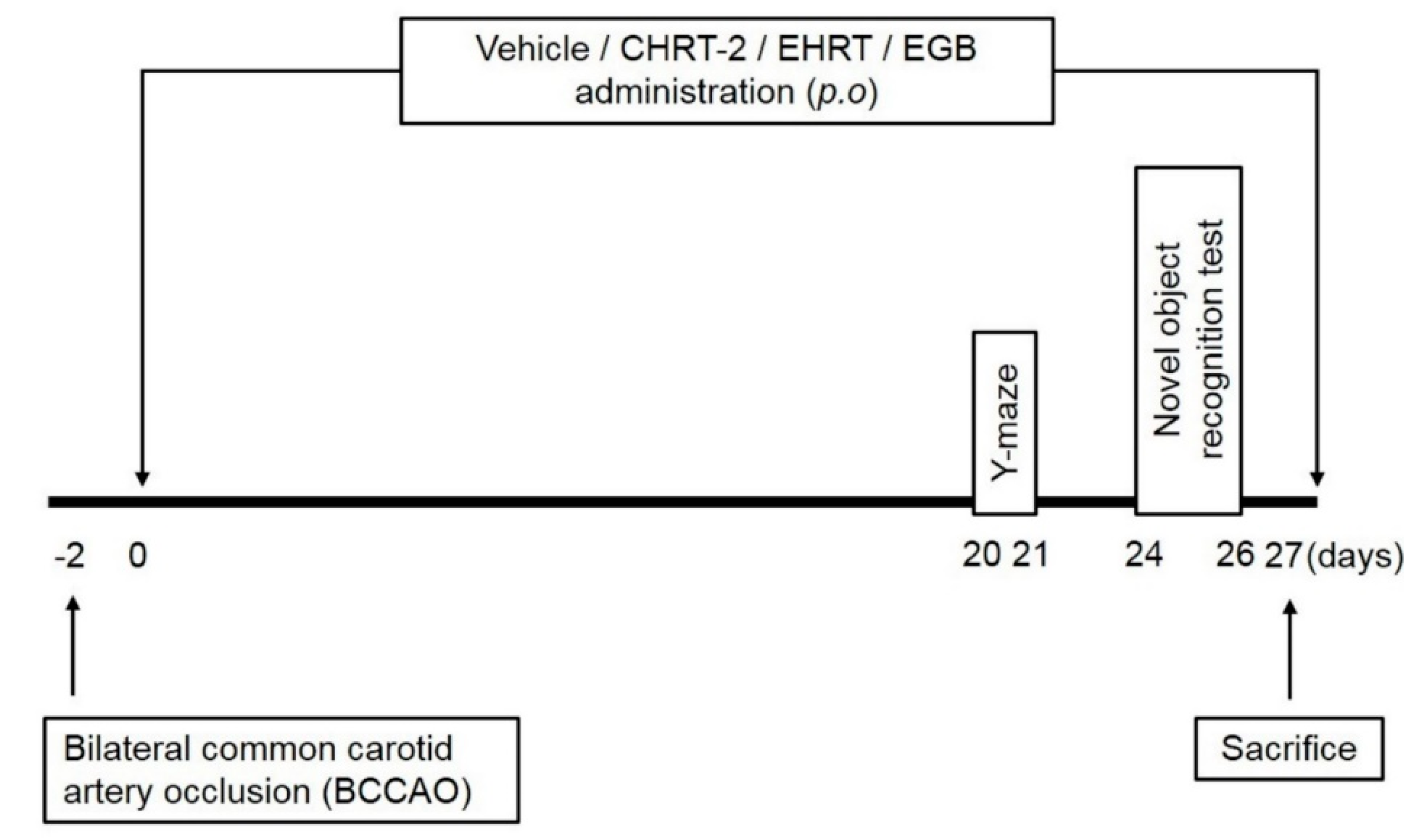
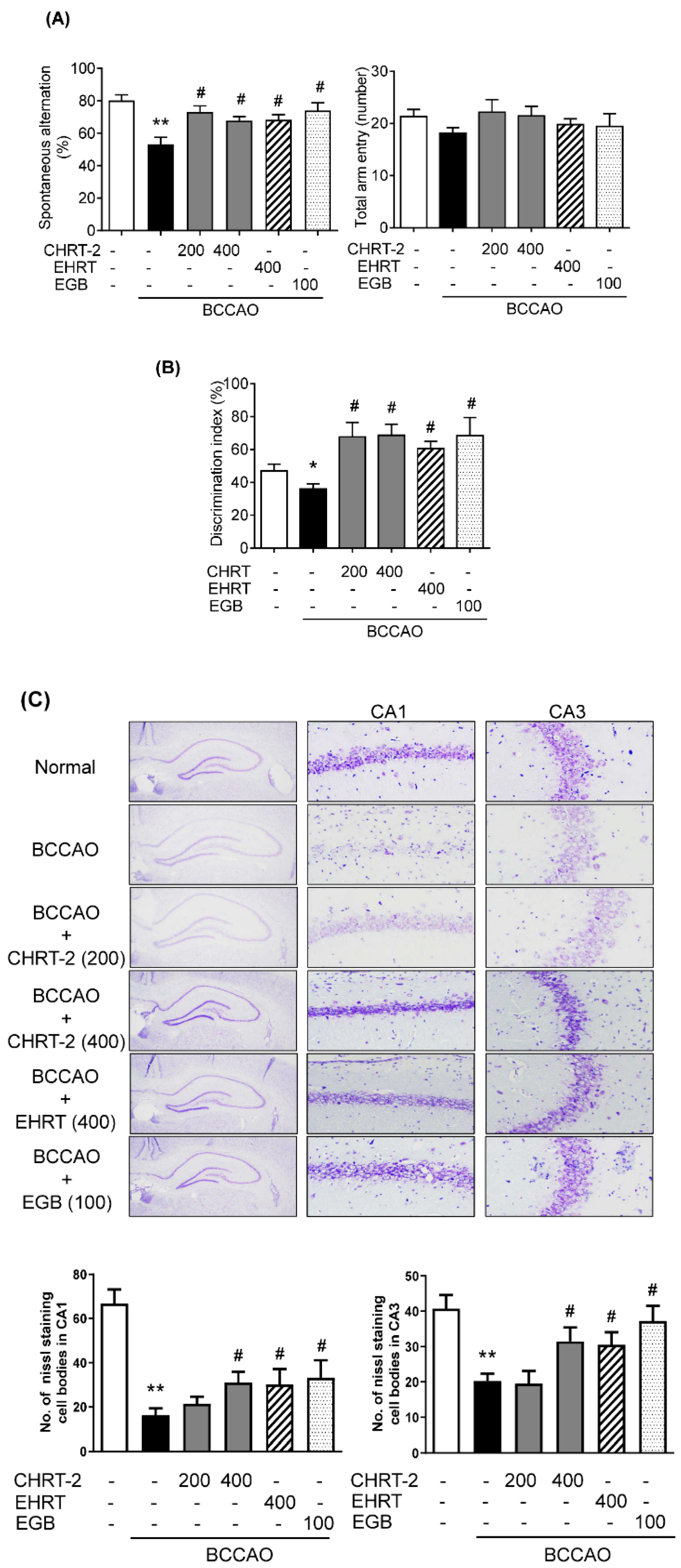
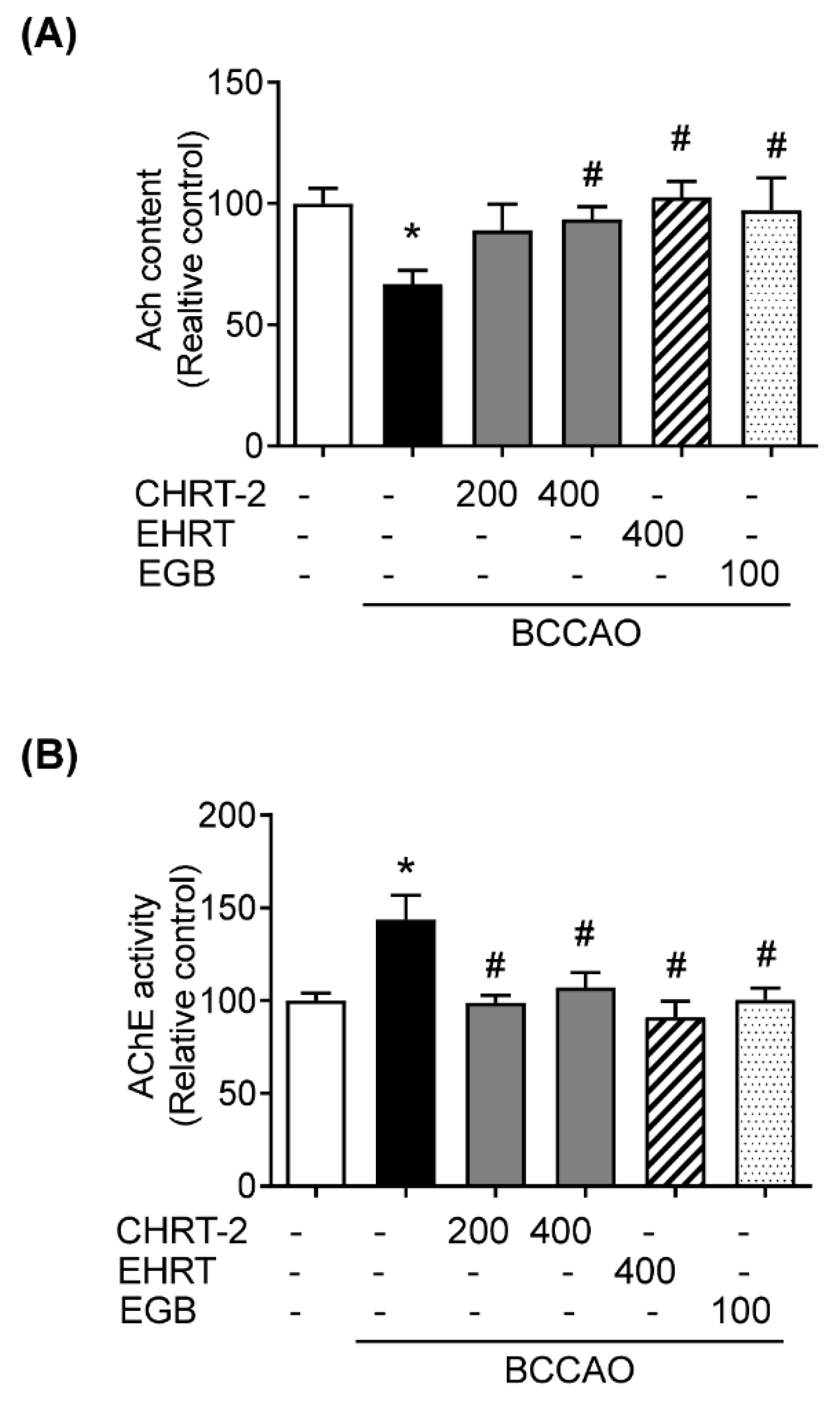

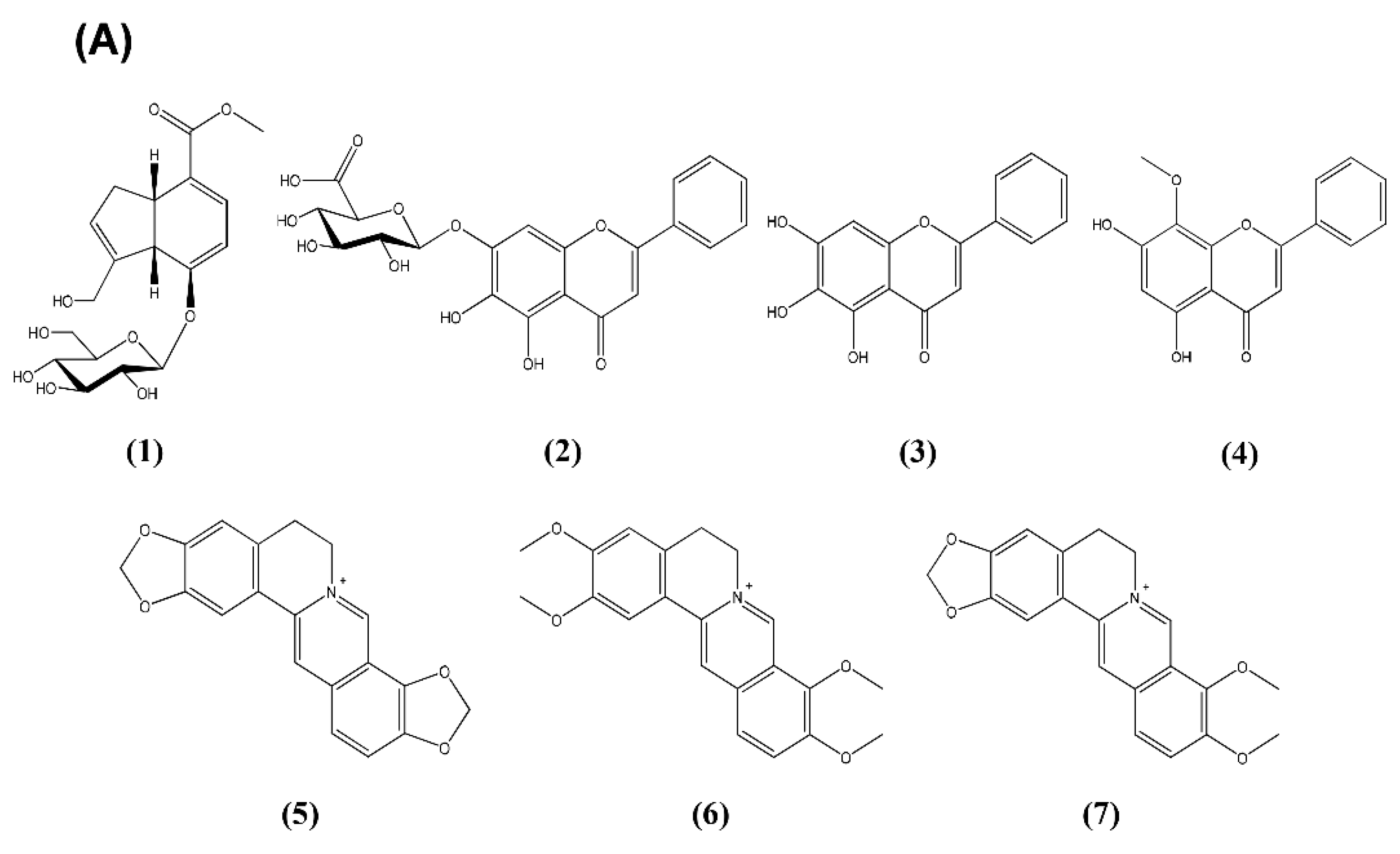
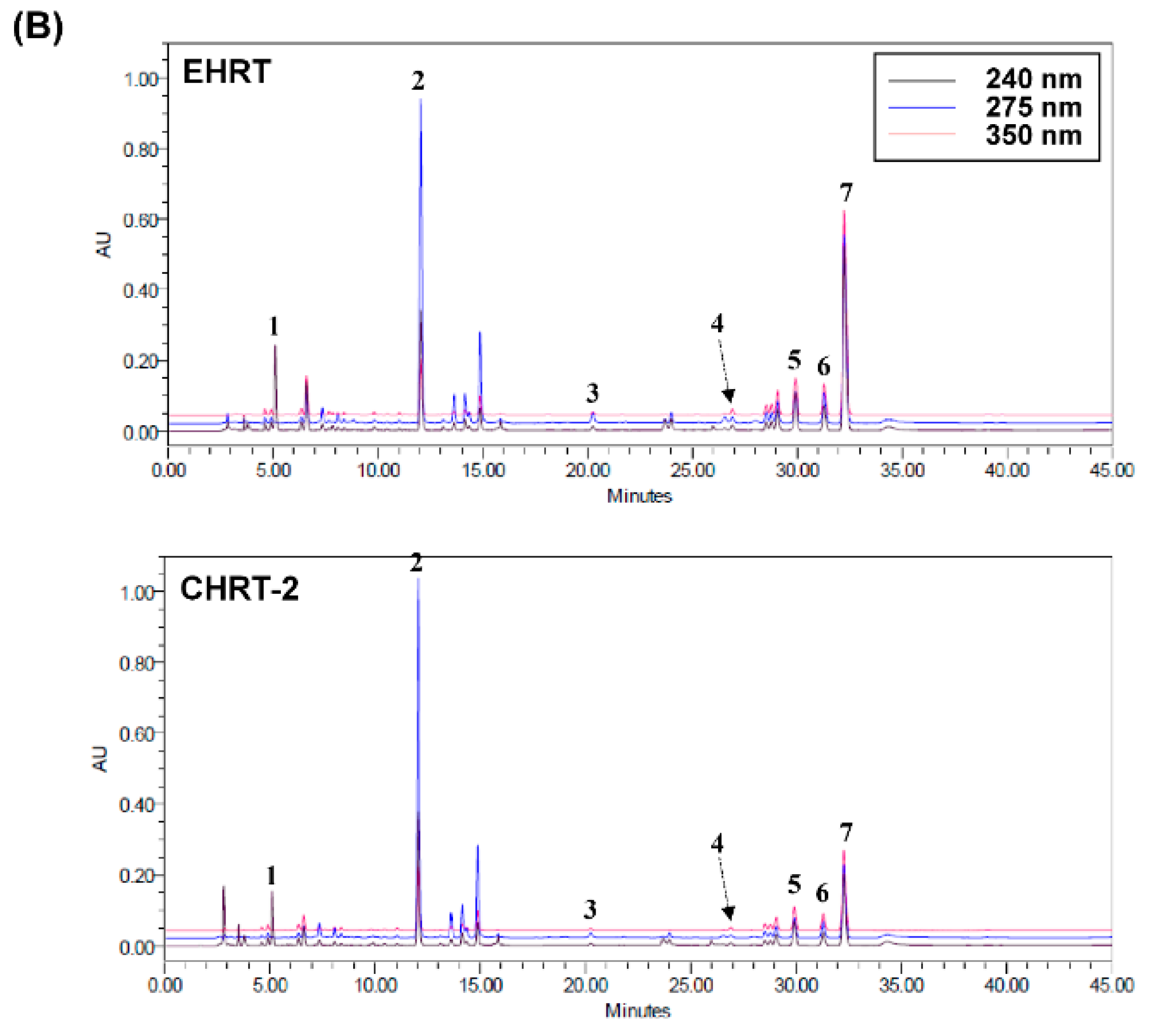
© 2019 by the authors. Licensee MDPI, Basel, Switzerland. This article is an open access article distributed under the terms and conditions of the Creative Commons Attribution (CC BY) license (http://creativecommons.org/licenses/by/4.0/).
Share and Cite
Sohn, E.; Kim, Y.J.; Lim, H.-S.; Kim, B.-Y.; Jeong, S.-J. Hwangryunhaedok-Tang Exerts Neuropreventive Effect on Memory Impairment by Reducing Cholinergic System Dysfunction and Inflammatory Response in a Vascular Dementia Rat Model. Molecules 2019, 24, 343. https://doi.org/10.3390/molecules24020343
Sohn E, Kim YJ, Lim H-S, Kim B-Y, Jeong S-J. Hwangryunhaedok-Tang Exerts Neuropreventive Effect on Memory Impairment by Reducing Cholinergic System Dysfunction and Inflammatory Response in a Vascular Dementia Rat Model. Molecules. 2019; 24(2):343. https://doi.org/10.3390/molecules24020343
Chicago/Turabian StyleSohn, Eunjin, Yu Jin Kim, Hye-Sun Lim, Bu-Yeo Kim, and Soo-Jin Jeong. 2019. "Hwangryunhaedok-Tang Exerts Neuropreventive Effect on Memory Impairment by Reducing Cholinergic System Dysfunction and Inflammatory Response in a Vascular Dementia Rat Model" Molecules 24, no. 2: 343. https://doi.org/10.3390/molecules24020343





